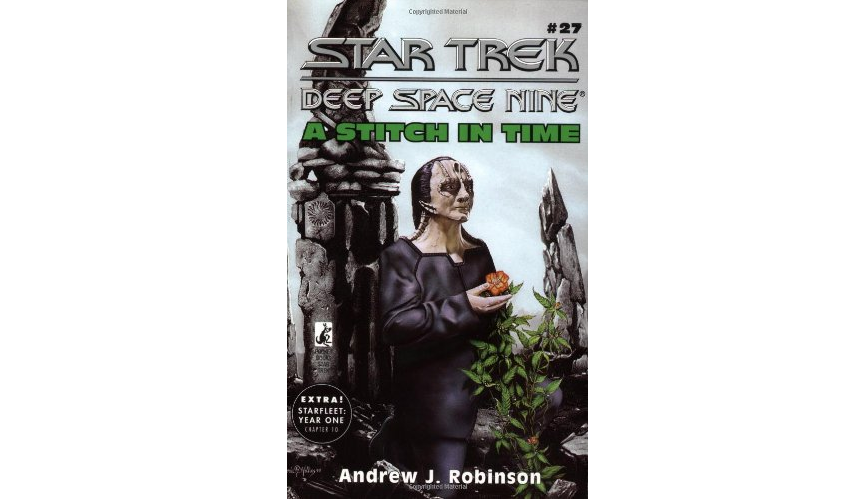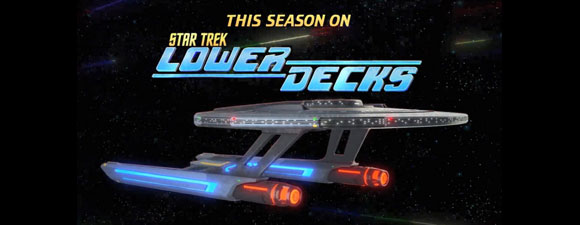Retro Review: Call To Arms
7 min readWith war looming, Dax and O’Brien mine the entrance to the wormhole, Sisko and Kira sabotage the station, Worf joins Martok’s fleet, and Rom and Leeta get married.
Plot Summary: As the Dominion sends more and more ships through the wormhole to Cardassia, Sisko decides that he must prevent any more Jem’Hadar troops from entering the Alpha Quadrant, even if it triggers the war that Starfleet now considers inevitable. While Dax and O’Brien brainstorm ways to stop the influx, Rom – who is worried about his non-traditional wedding to Leeta – offhandedly suggests self-replicating mines. Sisko agrees to this plan and sends Dax aboard the Defiant to put the minefield in place. Because Starfleet is busy plotting a sneak attack on the Dominion elsewhere, no ships can be spared for reinforcements, though Weyoun arrives to threaten an attack over the mines. Sisko tells Kira that he wants Bajor to accept the Dominion’s non-aggression pact, since it is the best way to protect Bajorans during the coming conflict. He then orders all Bajorans to be evacuated from the station, including Leeta, who ends up marrying Rom in a quick civil ceremony. As a representative of Bajor, Kira officially demands that Sisko turn over the station to Bajoran control before she helps him undermine all systems that would be useful to a Cardassian occupation force. Martok’s ships protect the Defiant until Dax can activate the minefield, though the limited Starfleet troops can’t defend the station from the large Dominion fleet that arrives and opens fire. Dukat is eager to take over Bajor as well as DS9, but Weyoun insists that as members of the Dominion, Cardassians cannot attack a planet which has agreed to avoid hostilities. After thanking the crew for keeping the Dominion busy while most of the Federation fleet was demolishing the shipyards in Cardassian space, Sisko beams aboard the Defiant to join the Starfleet attack force, unaware that Jake has remained behind to work as a reporter. Then Kira and Odo activate programs to sabotage the station’s computers and equipment before welcoming Weyoun and Dukat to a defenseless Terok Nor.
Analysis: The first time I saw “Call To Arms,” I rolled my eyes and braced myself for another letdown. I was expecting a repeat of Babylon 5‘s Shadow War – it was the year of fire, it was the year of destruction, it was the year of terrible letdown after a wonderful build-up to conflict. Because Star Trek had always been about avoiding conflicts, celebrating the peaceful future that Gene Roddenberry first imagined, it had always deflected the threat of war with speeches and cleverness, even against an enemy as implacable as the Borg. Despite the visible threat in the season five cliffhanger with an enormous Federation fleet poised for conflict with a deadly coalition of Cardassians and Jem’Hadar, I thought we’d get a couple of episodes of conflict, then a typical pat Trek resolution. There was no way to know that the franchise was on the verge of major change, the bravest and best writing it would offer before or since. With the Dominion War, the franchise makes good on the questions it posed then ducked with the Borg: What if the Federation came up against an enemy set on conquest, rejecting every effort at finding a resolution that would allow its member planets to keep their autonomy? What if that enemy had much greater resources than Starfleet? What if the Federation’s only choices were surrendering its member worlds to these invaders or using Starfleet for what, despite its missions to explore strange new worlds, to seek out new life and new civilizations, we’ve always known was the real purpose of all that military training? No, this isn’t Roddenberry’s Star Trek; I would argue that it’s better, a test to those lofty ideals in a context that’s real and relatable to people of our own time and place. Never do we get a stronger case for the values of infinite diversity in infinite combinations, respect for alternate cultures and viewpoints, making sacrifices to benefit the maximum number of people.
The differences between the Federation and the Dominion are put into stark relief not only in terms of how they cultivate potential allies – take Bajor, for one, which the Dominion attempts to swallow by force while the Federation spends years proving itself worthy – but in how its individual members work together. Where the Dominion actually breeds obedience into both its foot soldiers and its managers, Starfleet brings together old combatants like the Klingons and Humans, who not only work together but risk their lives for one another, with Martok taking his ship to the front line so he’ll be able to warn Sisko when the Dominion leaves Cardassian space and again to protect the Defiant during the attack. The love stories here may seem rushed and cheesy, but they’re also reflections of the sorts of freedoms and mutual respect at the core of Federation values – Rom and Leeta toss aside the complicated cultural issues involved in their wedding to make sure it happens before violence can tear them apart, Dax impulsively agrees to marry Worf so he doesn’t decide it’s a good day to die, Kira and Odo agree to set aside their relationship discomfort because they have more important things to worry about. These are each complicated, even problematic relationships – Rom can’t get over his fear that things won’t work out with Leeta, Worf and Dax have butted heads many times since they first got together, Odo and Kira are on a roller coaster that drove me crazy before I knew the writers were going to do right by them, both in the ways in which they would come together and the ways in which they never could. Compare these pairings – and Sisko and Yates, who is conspicuously absent here, and even Garak and Ziyal, a mismatch from the start – with the unholy marriage between the Cardassians and the Dominion exemplified by Weyoun and Dukat, who are already squabbling over how much independent power Cardassia will retain and who has final say over the fate of Bajor (as Dukat points out, the Dominion may have signed a pact with Bajor, but he never did).
When I first saw “Call To Arms,” I felt that Eddington had been premature talking about Les Miserables in “For the Uniform” because this episode reminded me much more of Les Mis – the musical – specifically “One Day More,” the big number near the end of the first act during which every character sings about his or her own personal worries on the eve of a battle that will change all their lives. The themes are in fact similar (young people wishing to become heroes, older men fretting about their children, lovers hoping to be reunited after the conflict, spies planning to punish rebels, opportunists trying to decide how best to benefit from the crisis). There’s certainly melodrama at work within the bombastic prelude to war, and it doesn’t always work, but on a rewatch I can’t figure out what annoyed me so much in the first place. We get to see Sisko both completely in charge and profoundly off-center; with Starfleet distracted elsewhere, he’s entirely responsible for strategy so far as the station and the wormhole are concerned, and he makes a choice both as Captain and Emissary that he feels is essential for Bajor though he finds it deeply distasteful in both roles (and, despite their differences, apparently both Winn and Shakaar trust him). He’s eclipsed in action both by Dax, who takes command of the Defiant for the critical task of deploying the minefield, and by Kira, who as the senior Bajoran must implement the plan to save Bajor by feigning surrender. We’ve seen Sisko pretend to give up the station before, when Bajorans being manipulated by Cardassian power-brokers tried to drive Starfleet away, but this time it won’t take only a few days to reveal the perfidy and bring everyone home.
In fact, the “home” that had started to become predictable a couple of years ago is gone, though that won’t be apparent to the people who live on Deep Space Nine for several more months. This is the beginning of an enormous change for the station and by extension for Star Trek, epitomized on the one hand by the image of the Defiant under Sisko’s command being engulfed by a fleet of ships even bigger than the one that fought the Borg at Wolf 359, and on the other hand by Kira, technically in command of the station, welcoming her old enemy Dukat and her new enemy Weyoun. Odo stands behind her, her closest friend and ally, officially a subordinate to all of the above as chief of security, yet greeted as a Founder and therefore a god by Weyoun. By the time Sisko reclaims the baseball he has left in his office to warn Dukat that he’ll be back, all of these relationships will have altered irrevocably at both a personal level and on a scale that affects half the galaxy. By the time the Federation can regroup and look at the new picture of its membership, far more will have changed than it did in a decade of fun with the Enterprise-D crew. What’s clear on a rewatch is that the writers never intended for there to be a way that Starfleet could win the Dominion War. It’s Star Trek’s Kobayashi Maru test: a no-win scenario. And unlike the Borg conflict, where a “sleep” cheat allowed Starfleet to change the game, there will be no shortcut or easy way out. After all the times Kirk and Picard averted wars with speeches, after the miraculous post-death revivals of Spock and Data and several others, Star Trek finally decides to take on war and death as reality, which makes for the best sort of science fiction.







This is the start of the very best part of the series. I love this episode, and most of the 6 story arc that starts the next season. It’s so real, the relationships dealt with so very well. I can’t agree more with this review and am very much looking forward to the reviews of the next few weeks.
Dominion War= The worst story idea in the history of Star Trek, an idea so bad it is only equaled by how bad a casting choice Scott Bakula is. There is nothing brave about writing a war to increase your ratings, its lazy.
I believe her reasoning for considering it brave is right there in the article: that it’s easy enough to hold to your lofty ideals until they’re put seriously to the test, and the war arc is that test. Are you going to reply specifically to this reasoning or what?
No I will not respond to that, War is always easier than Peace, ALWAYS, the second you give up and go to war you are abandoning all of those principles, her point is just idiocy.
So, any piece of art or entertainment that is anything other than strictly pacifistic deserves to be condemned? But this is beside the point: if you can’t see your way through to clarifying what you mean with specific points, then you well and truly have nothing to say worth hearing.
Just between you and me, I’m planning to break into Just a Guest’s house tonight around 3 a.m. and clean it out. I only target the homes of people who I know are just going to sit there without trying to stop me because they’d be abandoning their principles if they fought back. Thank goodness for these people, they make it so much easier….
That would be a big mistake if you did, I have 14 little friends who can all run faster than you (hint: bullets). I never said I was a pacifist, I am far from it. Personally I thought my point was completely clear but see if maybe you can get it this time. How hard is it to understand that if your “lofty ideal” is the “peaceful coexistence” that we have always been told is the entire purpose of Starfleet and the Federation (by everyone from Kirk on), then the second you go to war you have already abandoned that ideal, there is no holding on to it, peaceful coexistence and war are mutually exclusive always have been always will be. It is that simple.
Your point is quite clear; it is simply nonsensical within the context of DS9’s storyline and frankly leaves me to wonder whether you watched the show. The Federation’s ideals were never, at any stage of Trek’s history, a suicide pact.
War with the Dominion was the last thing the Federation wanted. The Federation had no wish to invade, to seize territory, to subjugate populations. But you “give up and go to war” when the alternative is death — your own and that of your civilization. Not all civilizations in Trek agreed with this — the Halkans, for example — but we are simply imperfect human beings. Even Kirk went to war when necessary; he once characterized himself as “a soldier, not a diplomat.”
Of course you are a pacifist, whether you wish to admit it or not (though, as you demonstrate, pacifism always seems to be the ideal everybody else should strive for). By the way, which room do you keep the flatscreen in? I better not be wasting my time and my superior firepower (14 bullets, heh) on something less than 60 inches.
I’d say “Voyager” and “Enterprise” came up with plenty of worse story ideas that didn’t generate nearly the amount of compelling characterization and layered storytelling that DS9 eked out of the war in season 6. I am very grateful to this show for trying something different and daring to bend the Trek rules for the sake of good drama. It’s because of choices like that that DS9 has aged better than any of its modern sister shows. It’s not about plots of the week and characters totally bent on getting along as friends. It injects believable drama, darkness and conflict into a beloved universe and makes it that much more rewarding a place to visit.
How would allowing themselves to be attacked by the Dominion be “peaceful coexistence?” How would it be supporting all those Federation members and allies who previously *were* peacefully coexisting and would be unable to after the Dominion attacked?
Even the Dalai Lama says it is reasonable to fight back while being attacked. Self-defense is not a violation of pacifistic ideals. Only initiating a war would be.